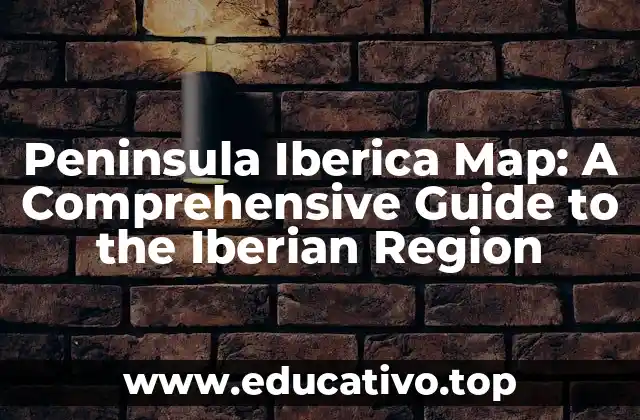Introducción a Peninsula Iberica Map
The Iberian Peninsula, located in southwestern Europe, is a region of immense cultural, historical, and geographical significance. Comprising modern-day Spain, Portugal, Andorra, and Gibraltar, this region has been a crossroads of civilizations for centuries. Understanding the Peninsula Iberica map is essential for grasping the complexities of this fascinating area. In this article, we will delve into the geography, climate, history, and cultural heritage of the Iberian Peninsula, providing a comprehensive guide to this enchanting region.
Geography of the Iberian Peninsula
The Iberian Peninsula is bounded by the Atlantic Ocean to the west, the Mediterranean Sea to the east, and the Pyrenees Mountains to the northeast. Covering an area of approximately 582,000 square kilometers, it is the second-largest peninsula in Europe. The terrain is characterized by mountains, plateaus, and coastal plains, with the highest point being the Mulhacén peak in the Sierra Nevada mountain range, reaching an elevation of 3,479 meters.
Climate of the Iberian Peninsula
The Iberian Peninsula experiences a Mediterranean climate, with warm summers and mild winters. The climate varies greatly from north to south, with the northern regions experiencing more rainfall and cooler temperatures than the southern regions. The coastal areas are generally milder than the inland regions, which can be quite hot during the summer months. The climate has played a significant role in shaping the region’s agriculture, architecture, and way of life.
What is the History of the Iberian Peninsula?
The Iberian Peninsula has a rich and complex history, with various civilizations having shaped the region over the centuries. From the ancient Celts and Tartessians to the Roman Empire, the Visigoths, and the Moors, each civilization has left its mark on the region’s architecture, art, and culture. The Reconquista, a period of Christian reconquest, and the subsequent rise of the Portuguese and Spanish empires, have all contributed to the region’s unique cultural heritage.
Cultural Heritage of the Iberian Peninsula
The Iberian Peninsula is home to a diverse array of cultures, languages, and traditions. From the vibrant cities of Barcelona and Lisbon to the historic landmarks of Seville and Granada, the region is steeped in history and culture. The Iberian Peninsula is also renowned for its rich artistic heritage, including the works of El Greco, Velázquez, and Gaudí. The region’s folk music, dance, and cuisine are equally impressive, with the flamenco, fado, and tapas being just a few examples of the region’s vibrant cultural landscape.
What are the Main Cities in the Iberian Peninsula?
The Iberian Peninsula is home to many vibrant cities, each with its own unique character and charm. From the bustling streets of Madrid and Lisbon to the historic centers of Seville and Porto, each city offers a unique glimpse into the region’s culture and history. Other notable cities include Barcelona, Valencia, and Granada, each with its own distinct architecture, cuisine, and cultural attractions.
Economy of the Iberian Peninsula
The Iberian Peninsula is a significant economic hub, with Spain and Portugal being among the largest economies in the European Union. The region is a major producer of agricultural products, with olive oil, wine, and citrus fruits being some of the main exports. The tourism industry is also a significant contributor to the region’s economy, with millions of visitors flocking to the region’s beaches, cities, and cultural attractions each year.
What is the Significance of the Iberian Peninsula in European Politics?
The Iberian Peninsula has played a significant role in European politics throughout history. From the Roman Empire to the modern-day European Union, the region has been at the forefront of European politics and diplomacy. The Iberian Peninsula is home to several international organizations, including the European Border and Coast Guard Agency and the European Maritime Safety Agency, making it a key player in European affairs.
How to Explore the Iberian Peninsula
Exploring the Iberian Peninsula can be a rewarding and enriching experience. From the scenic coastal routes to the historic cities and landmarks, there is no shortage of attractions to discover. Visitors can explore the region by car, train, or bus, with many towns and cities being easily accessible by air. With its warm climate, rich culture, and stunning landscapes, the Iberian Peninsula is a must-visit destination for any traveler.
What are the Must-Visit Attractions in the Iberian Peninsula?
The Iberian Peninsula is home to a plethora of must-visit attractions, including the Alhambra palace in Granada, the Sagrada Família in Barcelona, and the Jerónimos Monastery in Lisbon. The region is also home to several UNESCO World Heritage Sites, including the historic centers of Seville, Porto, and Évora. Visitors can also explore the region’s many national parks, including the Peneda-Gerês National Park in Portugal and the Sierra de Guadarrama National Park in Spain.
What is the Cuisine of the Iberian Peninsula?
The cuisine of the Iberian Peninsula is a delicious blend of Mediterranean and Atlantic flavors. From the savory tapas of Spain to the rich bacalhau dishes of Portugal, the region is renowned for its gastronomy. Visitors can sample the region’s famous seafood, including the fresh fish of the Atlantic coast and the rich seafood stews of the Mediterranean coast. The region is also home to several world-class wine regions, including the Douro Valley and the Rioja region.
What are the Best Festivals and Celebrations in the Iberian Peninsula?
The Iberian Peninsula is home to a vibrant cultural calendar, with numerous festivals and celebrations taking place throughout the year. From the Tomatina tomato-throwing festival in Spain to the Festa de Santo António in Portugal, visitors can experience the region’s rich cultural heritage firsthand. Other notable festivals include the Feria de Abril in Seville and the Festival de Jazz de Madrid.
What is the Future of the Iberian Peninsula?
The Iberian Peninsula is poised for a bright future, with both Spain and Portugal investing heavily in sustainable tourism, renewable energy, and innovation. The region is also a key player in European affairs, with several international organizations and diplomatic missions based in the region. As the region continues to evolve and grow, it is likely to remain a major cultural and economic hub in Europe.
How to Learn More about the Iberian Peninsula?
There are many ways to learn more about the Iberian Peninsula, from reading books and articles to watching documentaries and taking online courses. Visitors can also explore the region’s many museums and cultural institutions, including the National Archaeological Museum in Madrid and the National Museum of Ancient Art in Lisbon. With its rich history, vibrant culture, and stunning landscapes, the Iberian Peninsula is a region that has something to offer everyone.
What are the Challenges Facing the Iberian Peninsula?
Despite its many attractions and strengths, the Iberian Peninsula faces several challenges, including climate change, economic inequality, and migration. The region is also grappling with the ongoing COVID-19 pandemic, which has had a significant impact on the tourism industry and the regional economy. However, with its strong cultural heritage and resilient people, the Iberian Peninsula is well-equipped to overcome these challenges and continue to thrive.
How to Get Around the Iberian Peninsula?
Getting around the Iberian Peninsula is relatively easy, with a comprehensive network of roads, railways, and airports. Visitors can rent cars, take buses or trains, or fly between cities, making it easy to explore the region. The region is also home to several major ports, including the Port of Lisbon and the Port of Barcelona, making it a key hub for international trade and commerce.
Sofía es una periodista e investigadora con un enfoque en el periodismo de servicio. Investiga y escribe sobre una amplia gama de temas, desde finanzas personales hasta bienestar y cultura general, con un enfoque en la información verificada.
INDICE









